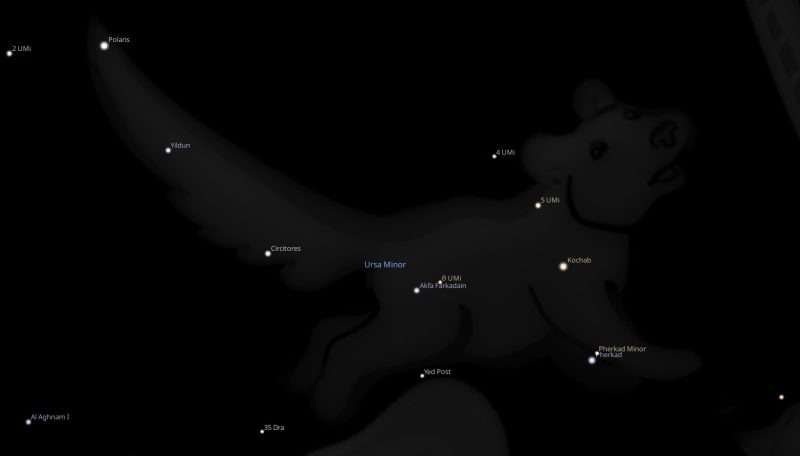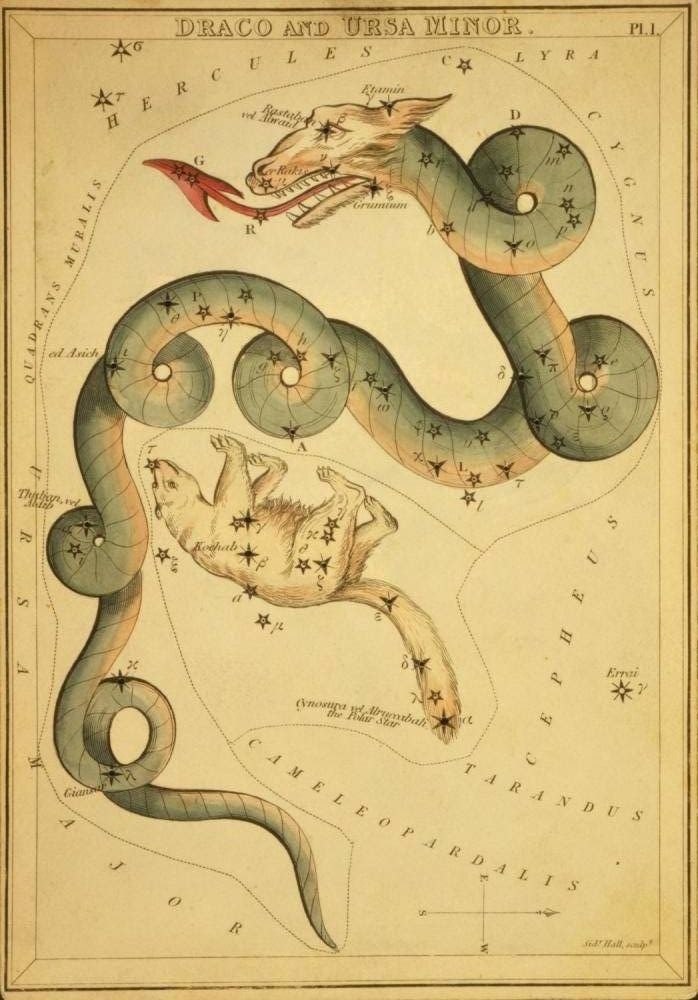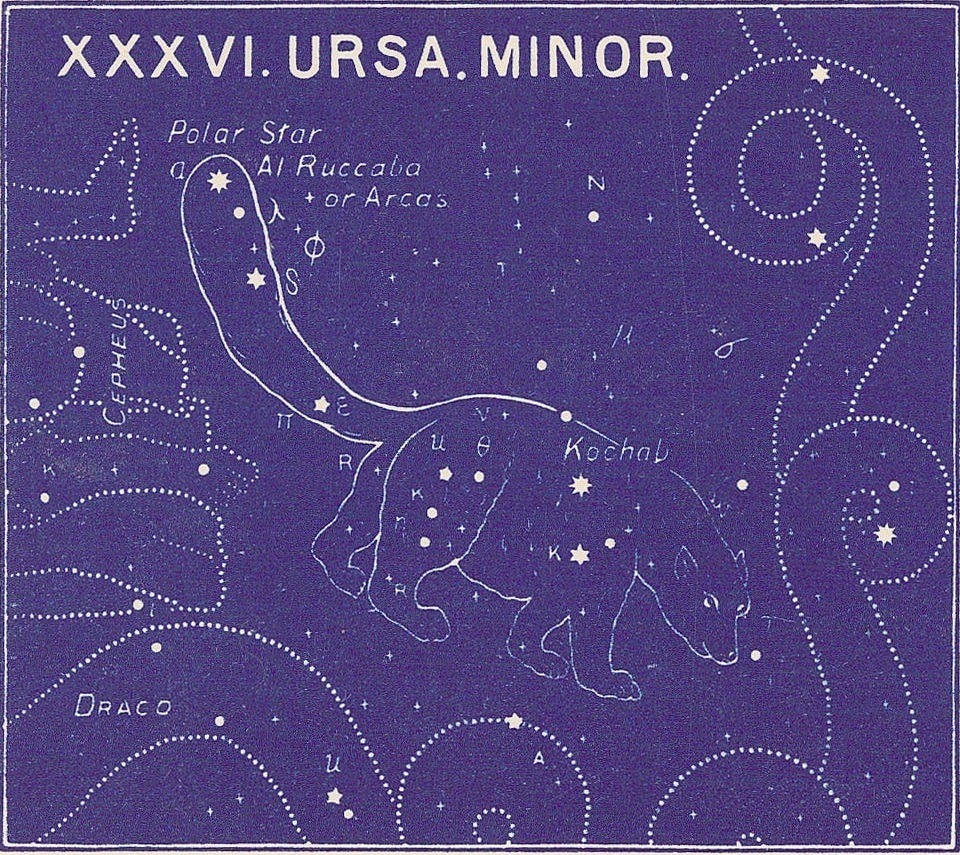FIXED STARS: Major Stars | 1000+ Stars | Constellations | About
Constellation Ursa Minor, the Little Bear, is a northern constellation bordering Draco, Cepheus, Camelopardalis and the obsolete constellation Rangifer.Ursa Minor is one of the 48 constellations listed by Ptolemy in the 2nd century and remains one of the 88 modern constellations. It spans over 70 degrees of the zodiac in the Signs of Gemini, Cancer, Leo and Virgo.
Abbreviation: UMi
Genitive: Ursae Minoris
Ursa Minor Constellation Stars
| 2000 | 2050 | Star | Name | Sp. Class | Mag. | Orb |
|---|---|---|---|---|---|---|
| 21♊28 | 22♊10 | 2 UMi | K2 | 4.24 | 1°20′ | |
| 28♊35 | 29♊17 | α UMi | Polaris | F7 | 1.97 | 2°20′ |
| 01♋13 | 01♋55 | δ UMi | Yildun | A1 | 4.35 | 1°10′ |
| 09♋09 | 09♋52 | ε UMi | Circitores | G5 | 4.21 | 1°20′ |
| 27♋26 | 28♋08 | ζ UMi | Ahfa al Farkadain | A3 | 4.29 | 1°20′ |
| 00♌20 | 01♌03 | η UMi | Yed Post | F5 | 4.95 | 1°00′ |
| 02♌50 | 03♌33 | 4 UMi | Hòu Gōng | K3 | 4.80 | 1°00′ |
| 08♌24 | 09♌07 | 5 UMi | Shù Zǐ | K4 | 4.25 | 1°20′ |
| 13♌20 | 14♌02 | β UMi | Kochab | K4 | 2.07 | 2°10′ |
| 21♌37 | 22♌20 | γ UMi | Pherkad | A3 | 3.04 | 1°50′ |
| 21♌40 | 22♌23 | 11 UMi | Pherkad Minor | K4 | 5.02 | 1°00′ |
Ursa Minor Astrology
Robson
Legend. According to some accounts this constellation represents Arcas, son of Callisto and Jupiter (see BOÖTES and URSA MAJOR). Other writers state that it is meant to represent Cynosura, one of the Nymphs of Crete who reared the infant Jupiter; the other, Helice, being Ursa Major.
Influence. According to Ptolemy the bright stars are like Saturn and in some degree like Venus. It is said to give indifference and improvidence of spirit, and to lead to many troubles. By the Kabalists it is associated with the Hebrew letter Tau and the 21st Tarot Trump “The Universe.”
Magical. Gives craft, ingenuity and valor. [1]
Noonan
Astrologically both Bears were said to presage an evil influence. They are particularly injurious as regards to the affairs of nations and kings. [2]
Allen
Ursa Minor, the Lesser Bear,
the Orsa Minore of Italy, Petite Ourse of France, and Kleine Bär of Germany, shared with its major companion the latter’s Septentrio, Ἄρκτος, Ἅμαξα, Ἄγαννα, and Ἑλίκη.
Similarly it was Κυνόσουρις, but solely Κυνόσουρα; this early and universal title, usually translated the “Dog’s Tail,” continuing as Cynosura down to the time of the Rudolphine Tables; although with us “Cynosure” is applied only to Polaris. The origin of this word is uncertain, for the star group does not answer to its name unless the dog himself be attached; still some, recalling a variant legend of Kallisto and her Dog instead of Arcas, have thought that here lay the explanation. Others have drawn this title from that of the Attican promontory east of Marathon, because sailors, on their approach to it from the sea, saw these stars shining above it and beyond; but if there be any connection at all here, the reversed derivation is more probable; while Bournouf asserted that it is in no way associated with the Greek word for “dog.”
Very recently, however, Brown has suggested that the word is not Hellenic in origin, but Euphratean; and, in confirmation of this, mentions a constellation title from that valley, transcribed by Sayce as An‑ta-sur‑ra, the Upper Sphere. Brown reads this An‑nas-sur‑ra, High in Rising, certainly very appropriate to Ursa Minor; and he compares it with Κ‑υν‑όσ‑ου‑ρα, or, the initial consonant being omitted, Unosoura. This, singularly like the Euphratean original, might easily become Kunosoura under the influence of a popular etymology, aided by the appearance of the tail stars of the constellation.
Ursa Minor was not mentioned by Homer or Hesiod, for, according to Strabo [I.1.6, C3], it was not admitted among the constellations of the Greeks until about 600 B.C., when Thales, inspired by its use in Phoenicia, his probable birthplace, suggested it to the Greek mariners in place of its greater neighbor, which till then had been their sailing guide. Aratos, comparing the two, wrote, as in our motto, of the Minor, its Guards, β and γ, then being much nearer the pole than was α, our present pole-star. Thales is reported to have formed it by utilizing the ancient wings of Draco, perceiving that the seven chief components somewhat resembled the well-known Wain, but reversed with respect to each other. From all this come its titles Φοινίκη, Phoenice, and Ursa Phoenicia.
The Arabians knew Ursa Minor as Al Dubb al Aṣghar, the Lesser Bear, — Bayer’s Dhub Elezguar, and Chilmead’s Dub Alasgar, — although earlier it was even more familiar to them as another Bier; and they called the three stars in the tail of our figure Banāt al Naʽash al Ṣughrā, the Daughters of the Lesser Bier.
Here, and in Ursa Major, some early commentators located the Fold, an ancient stellar figure of the Arabs, and an appropriate title, as Firuzabadi called β and the gammas in Ursa Minor Al Farḳadain, usually rendered the Two Calves, but, better, the Two Young Ibexes; Polaris, too, was well known as a Young He Goat, and adjacent stars bore names of desert animals more or less associated with a fold. Perhaps Lowell had this in mind when he wrote, in Prometheus, of.
Jensen sees here the Leopard of Babylonia, an emblem of darkness which this shared, there and in Egypt, with all other circumpolar constellations; while on the Nile it was the well-known Jackal of Set even as late as the Denderah zodiac. This Jackal also appears in the carvings on the walls of the Ramesseum, but is there shown with pendent tail strikingly coinciding with the outlines of the constellation.
Plutarch said that with the Phoenicians it was Doube or Dōbher (?), similar to the Arabian title, but defined by Flammarion as the “Speaking Constellation,” — better, I think, the “Guiding One,” indicating to their sailors the course to steer at sea. Jacob Bryant assigned it to Egypt, or Phoenicia, as Cahen ourah, — whatever that may be.
Caesius mentioned Catuli, and Canes Laconicae, the Lapdogs or Puppies, and the Spartan Dogs, as titles for both of the Bears.
With the Chinese it was Peih Sing.
IUrsa Minor, as now drawn, is enclosed on three sides by the coils of Draco; formerly it was almost entirely so. Argelander here enumerates 27 stars down to the 5½ magnitude, and Heis 54. [3]
Bullinger
It is sufficient to point to the fact that no Bear is found in any Chaldean, Egyptian, Pesian, or Indian Zodiacs, and that no bear was ever seen with such a tail! No one who had ever seen a bear would have called attention to a tail, such as no bear ever had, by placing in its very tip the most important, wondrous, and mysterious Polar Star, the central star of the heavens, round which all others revolve. The patriarchal astronomers, we may be sure, committed no such folly as this.
The primitive truth that there were two, or a pair of constellations is preserved; and that of these two, one is larger, and the other smaller. But what were they? We have the clue to the answer in the name of the brightest star of the larger constellation, which is called Dubheh. Now Dubheh means a herd of animals. In Arabic, Dubah means cattle. In Hebrew, Dohver, is a fold; and hence in Chaldee it meant wealth. The Hebrew Dohveh, means rest or security; and certainly there is not much of either to be found or enjoyed with bears! The word occurs in Deuteronomy 33:25 “As thy days so shall thy strength be.” The Revised Version gives in the margin, “So shall thy rest or security be.” This accords with what we have already seen under CANCER: “Couching down between the sheepfolds, he saw a resting-place that it was good.”
Here are the two Sheepfolds, then; the Greater fold, and Lesser; and here is the rest and security which the flocks will find therein. But in Hebrew there is a word very similar in sound, though not in spelling–dohv, which means a bear! So we find in Arabic dub; Persian, deeb and dob. We can see, therefore, how the Hebrew Dohver, a fold, and Dohv, a bear, were confused; and how the Arabic Dubah, cattle, might easily have been mistaken by the Greeks, and understood as a bear.
The constellation, which we must therefore call THE LESSER SHEEPFOLD, contains 24 stars, viz., one of the 2nd magnitude, two of the 3rd, four of the 4th, etc. The brightest star, α (at the point of the tail), is the most important in the whole heavens. It is named Al Ruccaba, which means the turned or ridden on, and is today the Polar or central star, which does not revolve in a circle as does every other star, but remains, apparently, fixed in its position. But though the star does not revolve like the others, the central point in the heavens is very slowly but steadily moving. When these constellations were formed the Dragon possessed this important point, and the star a, in Draco, marked this central point. But, by its gradual recession, that point is sufficiently near this star Ruccaba, in the Lesser Sheepfold, for it to be what is called “the Polar Star.” But, how could this have been known five or six thousand years ago? How could it have been known when it received its name, which means the turned or ridden on? That it was known is clear: so likewise was it made known in the written Word that the original blessing included not merely the multiplicaiton of the seed of faithful Abraham, but it was then added, “And thy seed shall possess the gate of his enemies” (Gen 22:17).
This star was called by the Greeks the “Cynosure.” ARATUS seems to apply this term to the whole of the seven stars of the Lesser Bear. Mr. Robert Brown, Jr., shows that this word once supposed to be Hellenic, is non-Hellenic, and possibly Euphratean in origin, from a word which he transliterates An-nas-sur-ra, and renders it, “as it literally means, high in rising, i.e., in heavenly position.” (Euphratean Stellar Researches). Is not this the primitve truth of the Revelation? Will not this Lesser Fold be high, yea, the highest in heavenly position?
The bright star β is named Kochab, which means waiting Him who cometh. Other stars are named Al Pherdadain (Arabic), which means the calves, or the young (as in Deut 22:6), the redeemed assembly. Another, Al Gedi, means the kid. Another is Al Kaid, the assembled; while Arcas, or Arctos (from which we derive the term Arctic regions), means, according to one interpreter, a travelling company; or, according to another, the stronghold of the saved. [4]
References
- Fixed Stars and Constellations in Astrology, Vivian E. Robson, 1923, p.65-66, 232.
- Fixed Stars and Judicial Astrology, George Noonan, 1990, p.7.
- Star Names: Their Lore and Meaning, Richard H. Allen, 1889, p.447-460.
- The Witness of the Stars, E. W. Bullinger, 1893, URSA MINOR (the Little Bear).


